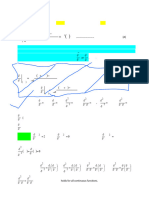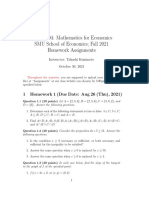Function of Many Variables
Uploaded by
Experimental BeXFunction of Many Variables
Uploaded by
Experimental BeXMathematics for Economics Anthony Tay
18. Partial Derivatives
The concept of “ceteris paribus” is one that is well known even to beginning students of economics. It
is a mental experiment where we consider the effect of a change in one variable on another variable
holding everything else fixed. The concept of partial derivatives delivers exactly these sorts of
statements.
Example 18.1 Let
= (k , l ) 2k 0.3l 0.5 be a production function with inputs k and l .
y f=
Suppose l is fixed at l = 4 . What is the effect on y of increasing k ?
0.3 0.5
If l = 4 , then
= (k , 4) 2k=
y f= 4 4k 0.3 . Thus fixing l = 4 reduces the problem to one with a
function of one variable, and we know how to proceed:
d
f (k , 4) = 1.2k −0.7 .
dk
If k = 1 , then df (1, 4) / dk = 1.2 , i.e. when k = 1 , a one-unit increase in k will increase output by
approximately 1.2 units. If k = 2 , then df (2, 4) / dk = 0.739 .
We can also consider higher derivatives. For instance,
d2
−0.84k −1.7 < 0 ,
f (k , 4) =
dk 2
so output increases at a decreasing rate as more capital is added to the process, if labor is held fixed at
l =4.
All these values would of course change if l were fixed at some other value:
If l = 9 , then
d d2
f (k ,9) = 6k 0.3 , f (k ,9) = 1.8k −0.7 and −1.26k −1.7 < 0
f (k ,9) =
dk dk 2
For any value of k , an increase in k will result in a larger increase in output than in the previous case
when l = 4 . Additional capital is more productive when l = 9 than when l = 4 , although this
productivity is diminishing at a faster rate. Clearly the effect on y of increasing k depends not only
on the value of k , but also on the value of l .
Mathematics for Economics 18-1
Partial Derivatives In practice, we do not need to repeat this process for specific values of l .
Instead, we simply treat l as fixed (as in the ceteris paribus mental experiment) and treat the function
as a function of one variable k . Then we can take derivatives in the usual way. We say we are taking
partial derivatives of y with respect to k , and write
∂y ∂f
= = fk′
= f1′ (k=
,l) 0.6k −0.7 l 0.5 .
∂k ∂k
(I have given four commonly used notations for partial derivatives -- use whichever notation seems
most appropriate or convenient in your given situation.)
Note the use of “ ∂ ” rather than " d " in the ∂y / ∂k notation. This is merely convention: we use ∂ when
the derivative is a partial derivative (some variable is being held constant) and “ d ” for derivatives of
functions of one variable.
Our answer to the question “what is the effect on y of increasing k when l is held at l = 4 ?” can then
be answered by putting l = 4 into the expression of the partial derivative
f1′ (k , 4)
= 0.6
= k −0.7 40.5 1.2k −0.7
In similar fashion, we can ask what the effect is on y of increasing l holding k fixed. We have
∂y ∂f
= = fl′
= f 2′ (k ,=
l) k 0.3l −0.5
∂l ∂l
∂z ∂z
Example 18.2 z = x 3 y 4 . Then = 3 x 2 y 4 , and = 4 x3 y 3 .
∂x ∂y
There is another notation for partial derivatives: given z = f ( x, y ) , I can also write f1′ for f x′ , and f 2′
for f y′ . The '1' in the subscript of f1′ means differentiate with respect to the first variable which appears
in the list of independent variables in f ( x, y ) , i.e., ' x ' . The '2' in the subscript of f 2′ means
differentiate with respect to the first variable which appears in the list of independent variables in
f ( x, y ) , i.e., ' y ' . This is especially useful when we apply the chain rule.
Mathematics for Economics 18-2
We can also take higher derivatives. In particular, for z = f ( x, y ) we define
∂2 f ∂ ∂f
2
≡ ≡ f xx′′
∂x ∂x ∂x
The interpretation of these two higher
2
∂ f ∂ ∂f partial derivatives should be obvious.
2
≡ ≡ f yy′′
∂y ∂y ∂y
∂2 f ∂ ∂f
≡ ≡ f yx′′ How does the “rate at which f changes with y ”
∂x∂y ∂x ∂y
change when x changes?
∂2 f ∂ ∂f How does the “rate at which f changes with x ”
≡ ≡ f xy′′ change when y changes?
∂y∂x ∂y ∂x
∂2 f ∂2 f
and are called cross-partials.
∂l ∂k ∂k ∂l
Example 18.3 For f (k , l ) = Ak a l b
∂f ∂f
= Aak a −1l b = Abk a l b −1
∂k ∂l
∂2 f ∂2 f
= Aa (a − 1)k a − 2l b = Ab(b − 1)k a l b − 2
∂k 2 ∂l 2
∂2 f ∂2 f
= Aabk a −1l b −1 = Aabk a −1l b −1
∂l ∂k ∂k ∂l
∂2 f ∂2 f
Notice that = .
∂l ∂k ∂k ∂l
This is not a coincidence. It turns out that the order with which you take cross partials is irrelevant. This
is a result known as Young’s Theorem, which we will not prove in this course.
Example 18.4 Let z = x / y . Then
∂z 1 ∂z x
= ; = − 2;
∂x y ∂y y
∂2 z ∂2 z 2x
= 0; = 3 ;
∂x 2 ∂y 2
y
∂2 z 1 ∂2 z 1
= − 2; = − 2.
∂y∂x y ∂x∂y y
Mathematics for Economics 18-3
Partial Derivatives of Functions of Many Variables If z = f ( x1 , x2 ,..., xn ) , we can ask how z
responds to a change in the variable xi , holding all other variables fixed. To answer such questions,
treat x1 , x2 ,..., xi −1 , xi +1 ,..., xn as constants, and differentiate z with respect to xi .
x4
Example 18.5 If f ( x, y, z ) = , then
yz
4 x3 x4 x4
f x′ = ; f y′ = − ; f z′ = − ;
yz y2 z yz 2
For each of the n partial derivatives of the function z = f ( x1 , x2 ,..., xn ) , we can compute n second-order
partial derivatives:
∂ ∂f ∂2 f
=f ij′′ =
∂x j ∂xi ∂x j ∂xi
In other words, for a function of n-variables, we have n 2 second-order partial derivatives. We often
organize these n 2 partial derivatives into the following square array, called the “Hessian Matrix”:
f ′′ (x) f12′′ (x) f1n′′ (x)
11
f ′′ (x) f 22′′ (x) f 2 n′′ (x)
f ′′(x) = 21
f n1′′ (x) f n 2′′ (x) f nn′′ (x)
x4
Example 18.6 f ( x, y , z ) =
yz
4 x3 x4 x4
f x′ = ; f y′ = − ; f z′ = − ;
yz y2 z yz 2
12 x 2 4 x3 4 x3
f xx′′ = f xy′′ = − f xz′′ = −
yz y2 z yz 2
4 x3 2 x4 x4
f yx′′ = − f yy′′ = f yz′′ =
y2 z y3 z y2 z2
4 x3 x4 2 x4
f zx′′ = − f zy′′ = f zz′′ =
yz 2 y2 z2 yz 3
We can compute even higher-ordered derivatives. It turns out that the cross-derivatives are the same
regardless of the order in which the differentiation was carried out. We have
f xy′′ = f yx′′ , f xz′′ = f zx′′ , f yz′′ = f zy′′
This is always true. For any function of n variables z = f ( x1 , x2 ,..., xn ) , we always have
∂2 f ∂2 f
= .
∂xi ∂x j ∂x j ∂xi
Mathematics for Economics 18-4
Exercises
f ( x + h, y ) − f ( x , y ) f ( x, y + h ) − f ( x, y )
1. Given f ( x, y ) below, find and . Find
h h
f ( x + h, y ) − f ( x , y ) f ( x, y + h ) − f ( x, y )
(i) lim h→0 and (ii) lim h→0
h h
(Comment: as you do these drills, try to get the intuition that you are, in the case of (i) differentiating
the function with respect to x , treating y as though it were a constant, and in the case of (ii),
differentiating the function with respect to y , treating x as though it were a constant.)
) 3x + 2 y ;
(a) f ( x, y=
(b) f ( x, y ) = 5 xy ;
) x2 + y 2 ;
(c) f ( x, y=
(d) f ( x, y ) = 4 x 2 y ;
(e) f ( x, y ) = 3 x 2 ;
(f) f ( x, y ) = y 2 / x ;
f ( x + h, y ) − f ( x , y ) f ( x, y + h ) − f ( x, y )
In each case, find lim h→0 and lim h→0
h h
2. For all of the functions f ( x, y ) in question 1, find
(a) f1′ and f 2′
(b) f11′′ , f 22
′′ , f12′′ , and f 21
′′ . Verify in each case that f12′′ = f 21
′′ .
3. For all of the functions f ( x, y, z ) in question 2 and 4, find
(a) f1′ , f 2′ , f3′
(b) f11′′ , f 22
′′ , f33
′′ , f12′′ , f 21
′′ , f13′′ , f31
′′ , f 23 ′′ . Verify in each case that f ′′ij = f ′′ji .
′′ and f32
4 (a) Given f ( x, y ) =x 2 + 2 xy + y 2 , find
(i) f (−1, 2) (ii) f (a, a ) (iii) f (1/ x,1/ y ) (iv) g ( x) = f ( x,1 / x)
(b) Given F ( x, y, z ) = y e x y z , find
(i) F (1,1,1) (ii) F ( x, x 2 , x 3 ) (iii) F ( x,1,1)
Mathematics for Economics 18-5
5. Let f ( x=
, y ) ln( y − 2 x) .
(i) Find the largest possible domain,
(ii) Find the range of the function when the function is defined over the largest possible
domain;
(iii) Find the largest possible domain if it is desired that f ( x, y ) ≥ 0 ;
(iv) Sketch the level curves f ( x, y ) = k for k = −1, 0, 1, 2 .
6. Given f ( x, y ) below, find f x′ ( x, y ) and f y′ ( x, y ) .
(a) f ( x, y ) =x 2 + 2 xy + y 2 x, y ) x 3 e − y + y 3
(b) f (=
x2 y3
(c) f ( x, y ) = x 2 ye xy (d) f ( x, y ) =
x+ y
7. Given f ( x, y ) =x 2 + 2 xy + y 2 , find
(a) [ f ( x + h, y ) − f ( x, y )]/ h
(b) [ f ( x, y + h) − f ( x, y )]/ h
In both cases, evaluate the expression when h → 0 .
8. The volume of a cone of height h and radius (at its base) r is given by
= ( r , h) π r 2 h / 3 .
V f=
How would you interpret the equation ∂V / ∂r =2V / r . Show that the change in the volume
of the cone as you increase its height while holding the base radius constant is proportional to
the area of the base.
9. Given w = f ( x, y, z ) below, find ∂w / ∂x , ∂w / ∂y , and ∂w / ∂z
x2 − y 2
(a) f ( x, y, z ) = ye xyz (b) f ( x, y, z ) =
y2 + z2
(c) f ( x, y, z ) = xyz (d) f ( x, y, z ) = ye z log( xz )
Mathematics for Economics 18-6
You might also like
- Answer Key To Midterm Exam For Math For Econ Fall2021No ratings yetAnswer Key To Midterm Exam For Math For Econ Fall202113 pages
- Partial Derivatives 2.1 First Order Partial Derivatives DefinitionNo ratings yetPartial Derivatives 2.1 First Order Partial Derivatives Definition31 pages
- Day8-9 - Function of Several Variables - v5No ratings yetDay8-9 - Function of Several Variables - v559 pages
- Partial Differentiation and Its ApplicationsNo ratings yetPartial Differentiation and Its Applications26 pages
- Lecture Notes: Optimisation: Kausik Chaudhuri100% (1)Lecture Notes: Optimisation: Kausik Chaudhuri52 pages
- Chapter 5: Functio Ns of Several Vari AblesNo ratings yetChapter 5: Functio Ns of Several Vari Ables94 pages
- GEC220 Note Functions of Several Variables PDFNo ratings yetGEC220 Note Functions of Several Variables PDF47 pages
- Y (X), F (T) - in Practical Applications, However, Quantities of Interest Are, X, X, X, X, X, X, X, X, X)No ratings yetY (X), F (T) - in Practical Applications, However, Quantities of Interest Are, X, X, X, X, X, X, X, X, X)8 pages
- 1.1 Partial Differentiation, Euler's TheoremNo ratings yet1.1 Partial Differentiation, Euler's Theorem12 pages
- Multivariable Linear Approximations & DifferentialsNo ratings yetMultivariable Linear Approximations & Differentials9 pages
- Math Emati CS: Partial Derivatives ReportNo ratings yetMath Emati CS: Partial Derivatives Report7 pages
- Lecture Notes (Chapter 1.3 Partial Derivative)100% (1)Lecture Notes (Chapter 1.3 Partial Derivative)10 pages
- 3_week_3회 11.3 Partial Derivatives_수업자료No ratings yet3_week_3회 11.3 Partial Derivatives_수업자료37 pages
- ECON 104: Mathematics For Economics SMU School of Economics Fall 2021 Homework AssignmentsNo ratings yetECON 104: Mathematics For Economics SMU School of Economics Fall 2021 Homework Assignments19 pages
- ECON 104: Mathematics For Economics SMU School of Economics Fall 2021 Homework AssignmentsNo ratings yetECON 104: Mathematics For Economics SMU School of Economics Fall 2021 Homework Assignments20 pages
- MFE Differentials & Higher Ordered ApproxNo ratings yetMFE Differentials & Higher Ordered Approx15 pages
- Group 4: A Description and Analysis of Singapore Food Agency (SFA)No ratings yetGroup 4: A Description and Analysis of Singapore Food Agency (SFA)7 pages
- AWS Solutions Architect Associate Study PlanNo ratings yetAWS Solutions Architect Associate Study Plan5 pages
- Class 10 Chemistry Chapter 4 Revision Notes100% (1)Class 10 Chemistry Chapter 4 Revision Notes2 pages
- Lesson 5 (PHILOSOPHIES OF BUSINESS PRACTICES)No ratings yetLesson 5 (PHILOSOPHIES OF BUSINESS PRACTICES)70 pages
- Updated Course Material 5 in Math 2 For 2nd Semester 2021 2022 For DistributionNo ratings yetUpdated Course Material 5 in Math 2 For 2nd Semester 2021 2022 For Distribution14 pages
- Weibull Analysis Guide & Case Study - Pardus ConsultingNo ratings yetWeibull Analysis Guide & Case Study - Pardus Consulting16 pages
- 5b Chemical Energetics - IGCSE Chemistry (0620)No ratings yet5b Chemical Energetics - IGCSE Chemistry (0620)21 pages
- Physical Education and Health 12: 3 Quarter Week 3No ratings yetPhysical Education and Health 12: 3 Quarter Week 36 pages
- The Literary Translator and The Concept of FidelityNo ratings yetThe Literary Translator and The Concept of Fidelity16 pages
- Learn STEM Online Course Learning Design Week 1No ratings yetLearn STEM Online Course Learning Design Week 118 pages
- Answer Key To Midterm Exam For Math For Econ Fall2021Answer Key To Midterm Exam For Math For Econ Fall2021
- Partial Derivatives 2.1 First Order Partial Derivatives DefinitionPartial Derivatives 2.1 First Order Partial Derivatives Definition
- Y (X), F (T) - in Practical Applications, However, Quantities of Interest Are, X, X, X, X, X, X, X, X, X)Y (X), F (T) - in Practical Applications, However, Quantities of Interest Are, X, X, X, X, X, X, X, X, X)
- Multivariable Linear Approximations & DifferentialsMultivariable Linear Approximations & Differentials
- ECON 104: Mathematics For Economics SMU School of Economics Fall 2021 Homework AssignmentsECON 104: Mathematics For Economics SMU School of Economics Fall 2021 Homework Assignments
- ECON 104: Mathematics For Economics SMU School of Economics Fall 2021 Homework AssignmentsECON 104: Mathematics For Economics SMU School of Economics Fall 2021 Homework Assignments
- Group 4: A Description and Analysis of Singapore Food Agency (SFA)Group 4: A Description and Analysis of Singapore Food Agency (SFA)
- Updated Course Material 5 in Math 2 For 2nd Semester 2021 2022 For DistributionUpdated Course Material 5 in Math 2 For 2nd Semester 2021 2022 For Distribution
- Weibull Analysis Guide & Case Study - Pardus ConsultingWeibull Analysis Guide & Case Study - Pardus Consulting
- Physical Education and Health 12: 3 Quarter Week 3Physical Education and Health 12: 3 Quarter Week 3
- The Literary Translator and The Concept of FidelityThe Literary Translator and The Concept of Fidelity






































































































